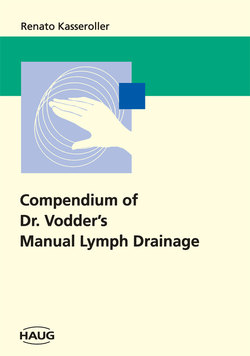Читать книгу Compendium of Dr. Vodder's Manual Lymph Drainage - Renato Kasseroller - Страница 8
ОглавлениеIntroduction
The human lymphatic system is one of many purification systems. However, one should not view its functions in isolation - which caution applies, by the way, to all organ systems, since man is far too complex a system for that. The high degree of specialization in the individual branches of medicine tends to obscure and impede comprehensive insights and understandings. The individual organs are interlinked by numerous regulatory cycles and control mechanisms. A holistic understanding of the human system is a prerequisite to correct understanding of the way that Manual Lymph Drainage works.
Man is both a closed and an open system. The skin is by no means a rigid barrier to the outside world: in the first place, the human body takes in too much via this organ; in the second place, too much is transported to the outside via the skin. From another viewpoint, however, the skin really is a clear demarcation boundary, as is shown by a partial alteration of the laws of gravity inside the human organism.
Lymphology, the study of the lymphatic system, is dedicated to researching the lymphatic vessel system and its connections with the other organs. Mastery of the technique of Manual Lymph Drainage, and success in its application, demands basic knowledge in certain areas of histology, anatomy, physiology and pathology.
The goal of Manual Lymph Drainage is to get bodily fluids flowing -either because they have become blocked for any number of reasons, or simply to accelerate the flow. Manual Lymph Drainage attempts to eliminate waste products from connective tissue and to improve the metabolic situation. Congestive conditions can be cleared up with this technique. This therapeutic result can even be improved and preserved by additional physical treatment methods.
Manual Lymph Drainage first works on the lymphatic vessel system mechanically; these mechanical stimuli then have a direct effect on the autonomic nervous system. When lymph drainage is properly applied, relaxation and a pleasant lassitude is induced; with Manual Lymph Drainage, we achieve a sympathicolytic effect in the vessel region, and the hypertonia of the patient's entire system is reduced, which has a calming (sympathicolytic) effect.
In certain areas, Manual Lymph Drainage works to stimulate the immune system, since the transport of immunocompetent cell systems is accelerated.
Manual Lymph Drainage's focus is on the connective tissue, which, according to Pischinger, should be considered to be a complete organ in its own right. It should not be viewed merely as a highway from blood vessel to cell; it is, rather, a cell-milieu system - which means, that each side depends on the other in equal and reciprocal partnership. This is reinforced by the nerve supply in every organ. [1]
Manual Lymph Drainage is above all about clinical practice, and so this book can only impart theoretical fundamentals. Most of one's learning can only be acquired in the ongoing work of daily practice.
